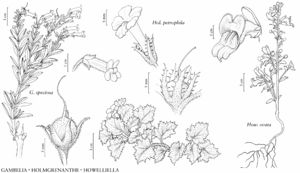Gambelia speciosa
Proc. Acad. Nat. Sci. Philadelphia 4: 7. 1848.
Plants 60–150 cm. Leaves: petiole 3–8 mm; blade elliptic to ovate, 15–45 × 4–26 mm, glabrous or glandular-hairy. Pedicels ascending, 10–20 mm. Flowers: sepals equal, lanceolate, 6–10 × 1–3 mm, apex acuminate, glandular-hairy; corolla tube 15–18 mm, glandular-hairy, palate inflated, abaxial plicae absent; lobes: abaxial spreading, adaxial erect, subequal, 2–5 mm, apex round; stamens included to slightly exserted, filaments incurved, abaxial 10–12 mm, adaxial 11–13 mm, pollen sacs oblong; ovary glandular-hairy, locules subequal; style included, 10–12 mm, base persistent in fruit, stigma slightly recurved. Capsules ovoid to globular, 6–9 mm. Seeds 1–2 mm, irregularly cristate. 2n = 30.
Phenology: Flowering Mar–Jun.
Habitat: Rock walls in coastal canyons, cliffs.
Elevation: 0–500 m.
Distribution
Calif., Mexico (Baja California).
Discussion
Gambelia speciosa is unique among the four species in Gambelia by its personate corolla and its geographic distribution on San Clemente and Santa Catalina islands (California) and Guadalupe Island (Mexico). Populations within and among islands are variable in indument.
Selected References
None.
